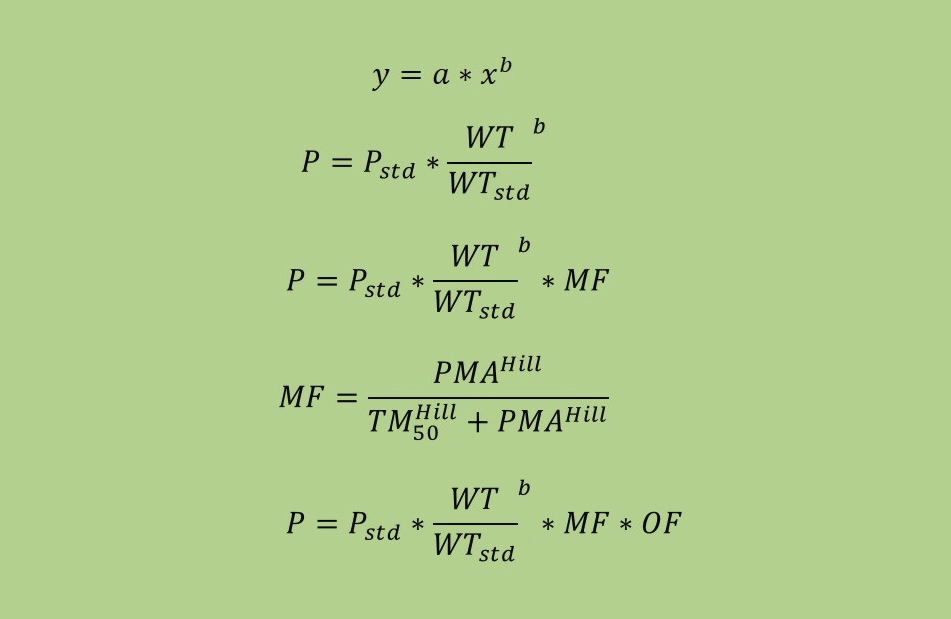This blog, adapted largely from an excellent article on the subject by Anderson et al., targets the pediatrician scientist who is wont to think that children are not small adults. As will be seen here and in the original article, there is lot to pediatric pharmacokinetics (PK) that can be extrapolated from adults.
Pediatric PK parameters can be extrapolated from those in adults by adjusting for differences in size (allometric scaling) and maturation (Hill equation). Based on the disease state (indication), a correction for organ function may also be required.
Size
PK parameters were traditionally scaled using a linear model (per kilogram). Subsequently, it was widely recognized that a non-linear model (allometric scaling) is perhaps more appropriate. This is expressed as:

where y is the dependent variable, x the body mass, a the allometric coefficient and b the allometric exponent.
For PK parameters this can be rewritten as:

where P is the PK parameter to be derived in a child of weight WT, Pstd is the known value for the PK parameter in an adult with weight WTstd and b is the allometric exponent, whose value (as described below) could vary depending on the parameter.
Initially, many parameters, including clearance, were thought to be a function of the basal metabolic rate (BMR), which in turn was thought to be a function of heat generated, which depended on body surface area (BSA). Body surface area was derived to be a function of mass with an exponent of 2/3. Thus, when P was clearance, b was thought to be 2/3. However, there are several assumptions in this derivation for BSA and therefore BMR (and clearance). In fact, it was found that across species, the log of BMR plotted against the log of body weight actually produced a straight line with a slope of 3/4 (Kleiber law). Thus b took the value of 3/4 for the PK parameter of clearance.
Allometric exponents range in values from -0.25 to 1:
Maturation
Allometric scaling assumes that organ function is mature; but this is not particularly true for children less than two years of age. Allometry alone is therefore insufficient to predict clearance in neonates and infants. The maturation function (MF) needs to be incorporated into the equation for the PK parameter.

The maturation process is best described by the sigmoid hyperbola using the Hill equation


where TM50 is the maturation half time, and the Hill coefficient relates to slope of the maturation profile. The post-menstrual age (PMA) is used instead of the post-natal age (PNA) as maturation can start before birth. TM50 and the Hill exponent have been derived for several parameters.
Organ Function
While allometry accounts for differences in size and the Hill equation corrects for immaturity, neither accounts for the disease state that might compromise organ function.
In order to account for the disease state, PK parameters (P) can be described in an individual as the product of size, maturation and organ function (OF) where Pstd is the value in a standard size adult without pathological changes in OF.

Thus if a diseased infant has a glomerular filtration rate (GFR) that is 50% of that in a healthy infant, then the OF is 0.5.
For an overview on pediatric drug development, please read our blog Pediatric Drug Development: Four Critical Considerations
References:
Anderson BJ, Holford NHG. Mechanistic Basis of Using Body Size and Maturation to Predict Clearance in Humans. Drug Metab. Pharmacokinet. 2009;24(1):25–36.
Lindstedt SL, Schaeffer PJ. Use of allometry in predicting anatomical and physiological parameters of mammals. Lab Anim. 2002 Jan;36(1):1-19.3.
West GB, Brown JH. The origin of allometric scaling laws in biology from genomes to ecosystems: towards a quantitative unifying theory of biological structure and organization. J Exp Biol. 2005;208:1575-92
For more blogs, please visit: https://www.rxmd.com/insights

